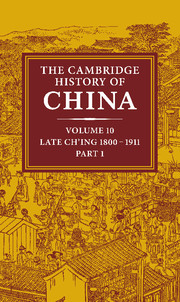Book contents
- Frontmatter
- 1 Introduction: the old order
- 2 Ch'ing Inner Asia c. 1800
- 3 Dynastic decline and the roots of rebellion
- 4 The Canton trade and the Opium War
- 5 The creation of the treaty system
- 6 The Taiping Rebellion
- 7 Sino-Russian relations, 1800–62
- 8 The heyday of the Ch'ing order in Mongolia, Sinkiang and Tibet
- 9 The Ch'ing Restoration
- 10 Self-strengthening: the pursuit of Western technology
- 11 Christian missions and their impact to 1900
- Bibliographical essays
- Bibliography
- Genealogical chart
- Glossary
- Index
- References
11 - Christian missions and their impact to 1900
Published online by Cambridge University Press: 28 March 2008
- Frontmatter
- 1 Introduction: the old order
- 2 Ch'ing Inner Asia c. 1800
- 3 Dynastic decline and the roots of rebellion
- 4 The Canton trade and the Opium War
- 5 The creation of the treaty system
- 6 The Taiping Rebellion
- 7 Sino-Russian relations, 1800–62
- 8 The heyday of the Ch'ing order in Mongolia, Sinkiang and Tibet
- 9 The Ch'ing Restoration
- 10 Self-strengthening: the pursuit of Western technology
- 11 Christian missions and their impact to 1900
- Bibliographical essays
- Bibliography
- Genealogical chart
- Glossary
- Index
- References
Summary
Traders came to China in the nineteenth century to extract profits. Diplomats and soldiers came to extract privileges and concessions. Alone among foreigners, Christian missionaries came not to take but to give, not to further their own interests but, at least ostensibly, to serve the interests of the Chinese. Why, then, of all those who ventured to China in the last century, was it the missionary who inspired the greatest fear and hatred?
If there is any one answer to this question, it is that the missionary was deeply – and unavoidably – committed to the proposition that the true interests of the Chinese people could be served only by means of a fundamental re-ordering of Chinese culture. Catholics and Protestants, liberals and conservatives – all shared in this commitment. Where they differed was less in ultimate goals than in the tactics to be used in pursuing these goals. China's conversion was their common object, and in the end they would be content with nothing less.
The vast majority of missionaries, Protestant and Catholic, were intolerant of Chinese culture and unwilling or unable to make meaningful adjustments to it. They devoted themselves tirelessly to religious proselytizing and tended to relegate secular change to a position of secondary importance. Although narrowly conservative in personal and religious outlook, their impact on the Chinese scene was the very opposite of conservative. For these were the missionaries whose demands on the native culture were the most unyielding – and hence, from a Chinese standpoint, the most overtly iconoclastic.
- Type
- Chapter
- Information
- The Cambridge History of China , pp. 543 - 590Publisher: Cambridge University PressPrint publication year: 1978
References
- 32
- Cited by



